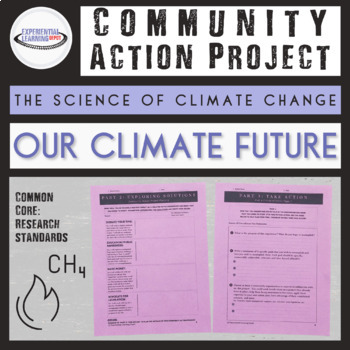Community Action Project: Our Climate Future {Printable and Digital}
- PDF
- Google Apps™

What educators are saying
Also included in
- Are you teaching high school climate change this year and are looking for a full climate change unit or course that is scientifically based? Are you looking for lesson plans for climate change that are hands-on, real-world, and inquiry-based? Are you hoping to teach an entire high school climate chaPrice $49.20Original Price $61.50Save $12.30
- This climate-change-themed problem-based learning curriculum mini-bundle includes four resources, all of which take the approach of looking at the climate change problem, exploring solutions, and acting on those solutions.Each student or small group of students will explore carbon cycle disruptors aPrice $18.00Original Price $22.50Save $4.50
Description
Have your students been studying the science of climate change, and now you really want to wrap up the unit in a powerful and meaningful way? A community action project is a fantastic way to do just that. My community action project is a sustained inquiry, project-based learning experience where my students study an issue or problem, research that issue, explore solutions, develop a course of action that they can take personally, and then take action.
This resource sets students up to do just that; take action on the issue of climate change, specifically as it relates to greenhouse gas emissions. Students will learn about sources that influence climate change and DO something to solve or mitigate the problem.
The materials included in this community action project guide students seamlessly through the process. The materials are intended to support independent and productive work on the part of your students. There is very little prep on your part. Simply introduce the experience, print the guiding templates, and facilitate their experiences.
The printable version (PDF) of this problem-based learning lesson plan is not editable at this time. The digital, Google Slides version offers more flexibility to overlay text or add/remove slides.
Note: As I already said, this is a great resource to end a climate change unit. If you are looking for experiential climate change resources, check out others from Experiential Learning Depot. I also have a complete science of climate change unit bundle, which includes this community action project. Consider getting the unit at a discounted price.
Product Includes:
- Teacher guide
- Project topic brainstorming activities - mind map & current events activity
- Two project proposal templates (1 - research the issue, 2- take action)
- Exploring solutions brainstorming guide
- Project Rubric 1: teacher-created rubric for project part 1 - researching the issue
- Project Rubric 2: student-generated rubric template for project part 2 - taking action
- Category and levels of mastery word banks for student-generated rubrics
- Daily check-in form
- Project reflection guide sheet
If you liked this resource, check out these products as well!
- Problem Based Learning Lesson Plan: Carbon Cycle Disruptors
- Self Directed Project Based Learning: Greenhouse Gases
Helpful FREE resources from Experiential Learning Depot
Helpful and Relevant Blog Posts from ELD
- How to Facilitate Self-Directed Community Action Projects
- How to Demonstrate Learning with Experiential Learning Digital Portfolios
Interested in new resource alerts, freebies, tips, tricks, and more?
- Click the green star to get new resource alerts
- Join my newsletter.
- Blog – Experiential Learning Depot
- Facebook.
- Facebook Group - Experiential Learning Community for k-12 Teachers
Earn TPT Credits:
Follow Experiential Learning Depot and earn TpT credits by giving feedback on this product. A sincere thank you for your business. Feel free to contact me through email at any time with questions on this product - experientiallearningdepot@gmail.com
Cover Font Credit: MR. FISK Fonts







